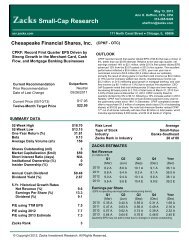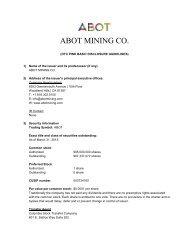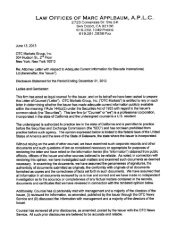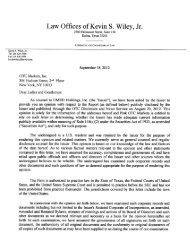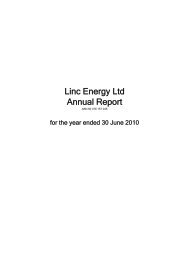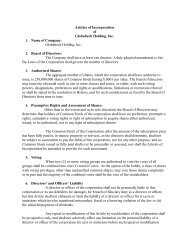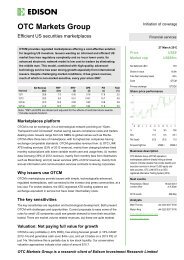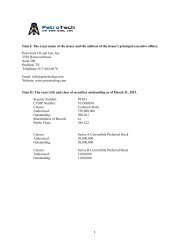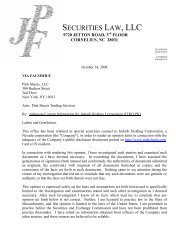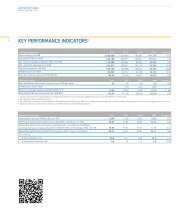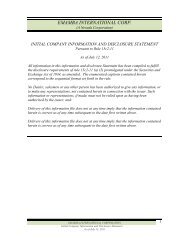2011 Annual Report - OTCIQ.com
2011 Annual Report - OTCIQ.com
2011 Annual Report - OTCIQ.com
Create successful ePaper yourself
Turn your PDF publications into a flip-book with our unique Google optimized e-Paper software.
Contingent liabilities are possible obligations toward third<br />
parties arising from past events that are not wholly within the<br />
control of the entity, or else present obligations toward third<br />
parties arising from past events in which an outflow of<br />
resources embodying economic benefits is not probable or<br />
where the amount of the obligation cannot be measured<br />
with sufficient reliability. Contingent liabilities are generally<br />
not recognized on the balance sheet.<br />
Where necessary, provisions for restructuring costs are recognized<br />
at the present value of the future outflows of resources.<br />
Provisions are recognized once a detailed restructuring plan<br />
has been decided on by management and <strong>com</strong>municated to<br />
the employees or their representatives. Only those expenses<br />
that are directly attributable to the restructuring measures<br />
are used in measuring the amount of the provision. Expenses<br />
associated with the future operation are not taken into consideration.<br />
In<strong>com</strong>e Taxes<br />
Under IAS 12, “In<strong>com</strong>e Taxes” (“IAS 12”), deferred taxes are recognized<br />
on temporary differences arising between the carrying<br />
amounts of assets and liabilities on the balance sheet and their<br />
tax bases (balance sheet liability method). Deferred tax assets<br />
and liabilities are recognized for temporary differences that<br />
will result in taxable or deductible amounts when taxable<br />
in<strong>com</strong>e is calculated for future periods, unless those differences<br />
are the result of the initial recognition of an asset or liability<br />
in a transaction other than a business <strong>com</strong>bination that, at the<br />
time of the transaction, affects neither accounting nor taxable<br />
profit/loss. IAS 12 further requires that deferred tax assets be<br />
recognized for unused tax loss carry forwards and unused tax<br />
credits. Deferred tax assets are recognized to the extent that<br />
it is probable that taxable profit will be available against<br />
which the deductible temporary differences and unused tax<br />
losses can be utilized. Each of the corporate entities is assessed<br />
individually with regard to the probability of a positive tax<br />
result in future years. Any existing history of losses is incorporated<br />
in this assessment. For those tax assets to which these<br />
assumptions do not apply, the value of the deferred tax assets<br />
is reduced.<br />
CEO Letter<br />
E.ON Stock<br />
Combined Group Management <strong>Report</strong><br />
Consolidated Financial Statements<br />
Corporate Governance <strong>Report</strong><br />
Supervisory Board and Board of Management<br />
Tables and Explanations<br />
Deferred tax liabilities caused by temporary differences associated<br />
with investments in affiliated and associated <strong>com</strong>panies<br />
are recognized unless the timing of the reversal of such<br />
temporary differences can be controlled within the Group<br />
and it is probable that, owing to this control, the differences<br />
will in fact not be reversed in the foreseeable future.<br />
Deferred tax assets and liabilities are measured using the<br />
enacted or substantively enacted tax rates expected to be<br />
applicable for taxable in<strong>com</strong>e in the years in which temporary<br />
differences are expected to be recovered or settled. The<br />
effect on deferred tax assets and liabilities of changes in tax<br />
rates and tax law is generally recognized in in<strong>com</strong>e. Equity<br />
is adjusted for deferred taxes that had previously been recognized<br />
directly in equity.<br />
Deferred taxes for domestic <strong>com</strong>panies are calculated using<br />
a total tax rate of 30 percent (2010: 30 percent). This tax rate<br />
includes, in addition to the 15 percent (2010: 15 percent)<br />
corporate in<strong>com</strong>e tax, the solidarity surcharge of 5.5 percent<br />
on the corporate tax (2010: 5.5 percent on the corporate tax),<br />
and the average trade tax rate of 14 percent (2010: 14 percent)<br />
applicable to the E.ON Group. Foreign subsidiaries use applicable<br />
national tax rates.<br />
Note 10 shows the major temporary differences so recorded.<br />
Consolidated Statements of Cash Flows<br />
In accordance with IAS 7, “Cash Flow Statements” (“IAS 7”),<br />
the Consolidated Statements of Cash Flows are classified<br />
by operating, investing and financing activities. Cash flows<br />
from discontinued operations are reported separately in<br />
the Consolidated Statement of Cash Flows. Interest received<br />
and paid, in<strong>com</strong>e taxes paid and refunded, as well as dividends<br />
received are classified as operating cash flows, whereas dividends<br />
paid are classified as financing cash flows. The purchase<br />
and sale prices respectively paid (received) in acquisitions<br />
and disposals of <strong>com</strong>panies are reported net of any cash and<br />
87



